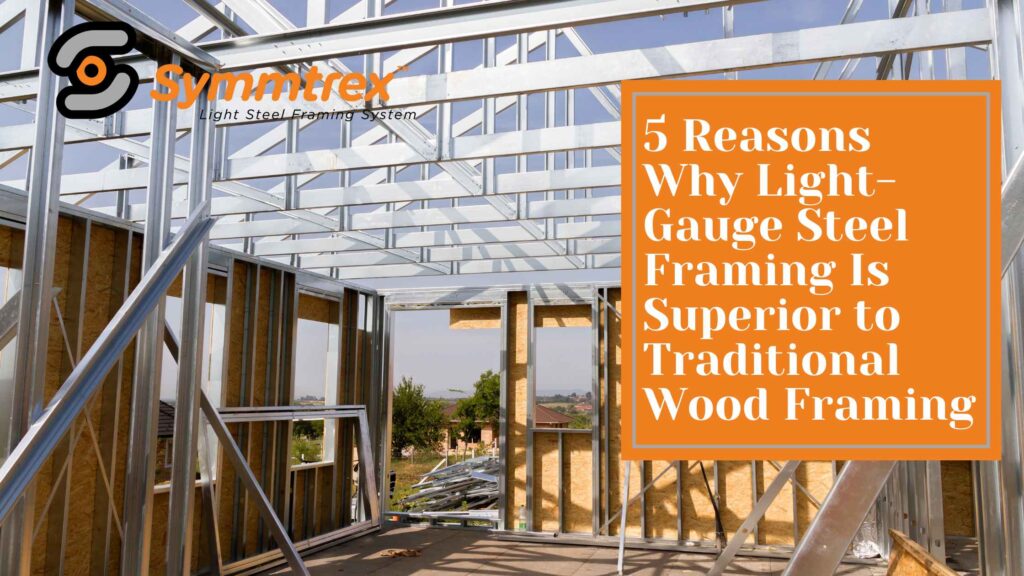
When it comes to construction, choosing the right framing material is critical. While traditional wood framing has long been the go-to option, light-gauge steel framing is rapidly gaining popularity for its numerous advantages. In this blog post, we’ll explore five compelling reasons why light-gauge steel framing is superior to traditional wood framing.
1. Durability and Strength
Superior Strength and Longevity
Light-gauge steel framing offers exceptional strength and durability compared to wood framing. Steel’s inherent properties make it resistant to various factors that can compromise the integrity of wood.
- Resistance to Pests: Unlike wood, steel is impervious to termites, carpenter ants, and other pests that can cause significant damage over time.
- Resistance to Rot and Mold: Steel does not absorb moisture, making it resistant to rot and mold. This ensures the structural integrity of the building remains intact for years.
- No Warping or Shrinking: Steel maintains its shape and size regardless of environmental conditions, unlike wood, which can warp, shrink, or swell due to changes in humidity and temperature.
Increased Load-Bearing Capacity
The high tensile strength of steel allows for greater load-bearing capacity, enabling the construction of larger and more complex structures without compromising safety or stability.
2. Fire Resistance
Enhanced Building Safety
One of the most significant advantages of light-gauge steel framing is its fire-resistant properties. Steel is non-combustible, meaning it does not burn or contribute to the spread of fire.
- Improved Fire Safety: Buildings framed with steel are less likely to collapse during a fire, providing more time for occupants to evacuate and firefighters to respond.
- Reduced Fire Damage: Steel’s resistance to fire can result in less structural damage, reducing repair costs and downtime after a fire incident.
Lower Insurance Premiums
Due to its fire-resistant nature, buildings constructed with steel framing often qualify for lower insurance premiums, resulting in long-term cost savings for property owners.
3. Environmental Impact
Sustainability Benefits
Light-gauge steel framing is an environmentally friendly choice for several reasons, making it a sustainable alternative to traditional wood framing.
- Recyclability: Steel is 100% recyclable and can be reused indefinitely without losing its properties. This reduces the demand for new raw materials and minimizes waste.
- Reduced Deforestation: Opting for steel framing helps conserve forests by reducing the need for timber. This contributes to biodiversity preservation and the reduction of carbon emissions associated with deforestation.
Energy Efficiency
The precision of steel manufacturing allows for tighter building envelopes, improving energy efficiency and reducing the building’s overall carbon footprint.
4. Cost Efficiency
Life-Cycle Cost Benefits
While the initial cost of steel framing may be higher than wood, the long-term cost benefits make it a more economical choice over the building’s lifecycle.
- Reduced Maintenance Costs: Steel’s resistance to pests, rot, and mold translates to lower maintenance and repair costs over time.
- Lower Insurance Costs: Buildings with steel framing often benefit from reduced insurance premiums due to their enhanced fire resistance and durability.
- Minimal Material Waste: The precision of steel fabrication results in minimal material waste during construction, optimizing cost efficiency.
Faster Construction Times
Steel framing components are often prefabricated, allowing for quicker assembly on-site. This reduces labor costs and accelerates project timelines, leading to faster occupancy and revenue generation.
5. Design Flexibility
Architectural Advantages
Light-gauge steel framing offers unparalleled design flexibility, enabling architects and builders to create innovative and aesthetically pleasing structures.
- Longer Spans: Steel’s high strength-to-weight ratio allows for longer spans without the need for intermediate supports. This means more open spaces and flexible floor plans.
- Customizable Designs: Steel can be easily shaped and customized to meet specific design requirements, allowing for unique architectural features and complex geometries.
- Increased Floor Area: Thinner steel framing components take up less space than traditional wood framing, increasing the usable floor area within the same building footprint.
Adaptability
Steel framing systems are highly adaptable and can accommodate future modifications or expansions with minimal disruption. This makes steel-framed buildings more versatile and adaptable to changing needs.
Conclusion
Light-gauge steel framing is rapidly emerging as the superior choice over traditional wood framing for modern construction. Its durability, fire resistance, environmental benefits, cost efficiency, and design flexibility make it an ideal solution for a wide range of building projects. By embracing light-gauge steel framing, builders and developers can achieve sustainable, resilient, and cost-effective structures that stand the test of time.
Ready to experience the benefits of light-gauge steel framing for your next project? Contact us today to learn more about how we can help you build stronger, safer, and more sustainable buildings.

